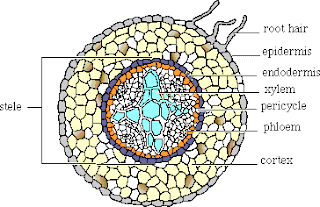The Pipelines of The Tree.
Trees need CO2, water, sunlight, and nutrients. Three things affect these essential components in tree growth - and they are tree characteristics, site characteristics, and climate. The tree has two major pipelines - one that carries water and nutrients from the ground to the leaves - and other (mainly down) carries all the carbohydrates (mainly sugars) to growth and storage areas of the tree.
Look at this basic diagram of the tree trunk:
 |
| Cross Section of tree trunk showing the basic components |
As you can see the major parts are the outer bark, then the cambium, sapwood and then central heartwood. So wheres the pipes? Look at this diagram of a cross section of root magnified and you can see all the cells that make up the basic pipeline.
 |
| The phloem and xylem here are dominant with not heartwood. |
The phloem lies just under the bark of a tree trunk and this mainly fibrous tissue carries sugars down from the leaves to growth and storage areas. Could be called a feeding pipe or downpipe.
The xylem is composed of the sapwood and heartwood combined and carries water & nutrients to the leaves. The sapwood is the major transport area and is lighter than the heartwood. The heartwood is mainly for strength of the tree.
Trees are mainly carbon, but to ensure healthy growth, trees also need oxygen, hydrogen, nitrogen, potassium, calcium, magnesium, phosphorus, sulphur, and trace elements.
CO2 and sunlight are absorbed by the leaves, water is absorbed by the roots, and nutrients are absorbed mostly by the roots but also by the leaves. The chlorophyll that enables the sun’s energy to convert carbon dioxide and water into sugar through photosynthesis.
How does water rise in some cases over 100 metres from the ground to the leaves - as there is no electric pump, heart or anything to assist this? In some cases waters rises at the rate of 30 meters per hours and in large volumes. It all starts in the root area where the cells contain sugars and minerals dissolved and this will pull water from the ground into these cells through osmosis, and the water pressure then transfers the flow onto the next cells upward and so on. This is repeated throughout the xylem or sapwood until it is released into the tissue of the leaves. Also involved in this is the evaporation of water from the leaves into the air - that is called transpiration - and will cause a vacuum effect that is quickly filled by water rising up the trunk. In some cases during rapid growth a tree may only utilise 1% of the water sent up the tree to the leaves - with the rest lost to the atmosphere.
 |
| Parts of a Tree |
As you can see the trees trunk, branches and roots are all set up in a similar way that helps these pipelines operate.
The phloem is the section between the bark and the cambium layer - and this carries the sugars around to differentt areas of the tree ranging from the roots to new growth tips at the very top. The phloem is only small compared to the xylem in the main trunk as it only carries the concentrated sugars to the growth and storage areas.
 |
| The parts of the trunk |
The cambium is the main growth or cell making area of the tree. It provides new cells for the phloem and xylem and will continually lay down these new tissues at a rapid rate. The outer bark is the main protection for the whole tree interior pipework - and will vary greatly from species to species.







